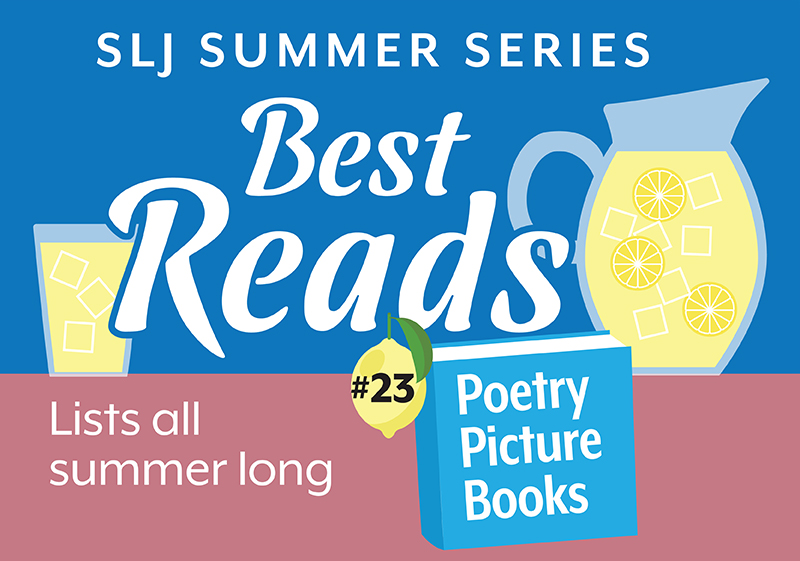12 Picture Book Journeys into Poetry | Summer Reading 2020
From Kwame Alexander to Gwendolyn Brooks and Maya Angelou, we've selected some of our favorite poets to remind readers that summer is the time to slow down and savor the sounds of words.
 |
See more Summer Reading 2020 selections |
From Kwame Alexander to Gwendolyn Brooks and Maya Angelou, we've selected some of our favorite poets to remind readers to slow down and savor the sounds of words.
How To Read a Book by Kwame Alexander. illus. by Melissa Sweet. HarperCollins/Harper. ISBN 9780062307811.
From Alexander’s sumptuous poetry, comparing reading to peeling the skin of a clementine, digging into its juiciness, enjoying it “piece by piece, part by part,” to Sweet’s ingeniously detailed mixed-media collage artwork, children are encouraged to slow down, “get cozy between the covers,” and spend time enjoying and exploring every morsel of word and image in this glorious homage to the magic of reading.
Superlative Birds by Leslie Bulion. illus. by Robert Meganck. Peachtree. ISBN 9781561459513.
This combination poetry/science book successfully blends language arts and science into an informative and fun collection of poems about the fastest, smallest, biggest, and most interesting birds
Cats Are a Liquid by Rebecca Donnelly. illus. by Misa Saburi. Holt/Godwin Bks. ISBN 9781250206596.
A bevy of things cats are and aren’t is explored in rhythmic, poetic text. “Cats fill./Cats spill./Cats flow downhill./Cats tip./Cats drip./Cats grip, snip, rip./Cats are a liquid/except when they’re not.” A vast variety of hilarious cats and kid scientists are depicted on the spreads, which match and give depth to the text, as they explore the laws of nature.
Rise!: From Caged Bird to Poet of the People, Maya Angelou by Bethany Hegedus. illus. by Tonya Engel. Lee & Low. ISBN 9781620145876.
Maya Angelou overcame an utterly terrifying childhood experience that left her temporarily mute. Despite these challenging circumstances, she went on to accomplish so much. Yet her success may have had a completely different outcome had she not had the love and support of a few key people who helped her turn fear into courage.
Nine: A Book of Nonet Poems by Irene Latham. illus. by Amy Huntington. Charlesbridge. ISBN 9781623541163.
This colorful picture book of nonets (not to be confused with sonnets) features poems that incorporate the number nine. The lesser-known form of poetry is defined as “a nine-line poem in which the first line contains nine syllables; the next line, eight syllables; and so on until the last line has one syllable, or the reverse, with one syllable in the first line and nine in the last.” The poems spotlight baseball games, circuses, armadillos, and planets.

Afternoon on a Hill by Edna St. Vincent Millay. illus. by Paolo Domeniconi. Creative Editions. ISBN 9781568463346.
Edna St. Vincent Millay’s short poem describes how she expects to enjoy nature on a hill. She will touch but not pick the flowers, look at cliffs and clouds, and watch the wind blow the grass.
A New Green Day by Antoinette Portis. illus. by the author. Holiday/Neal Porter Bks. ISBN 9780823444885.
A nameless girl is awoken by the sun streaming through her window. The narrative then focuses on the everyday happenings of the natural world.
16 Words: William Carlos Williams and “The Red Wheelbarrow" by Lisa Rogers. illus. by Chuck Groenink. Random/Schwartz & Wade. ISBN 9781524720162.
Rogers delves into the larger story behind William Carlos Williams’s famous poem “The Red Wheelbarrow,” opening a window into the poet’s life and inviting children to consider what lies beyond those simple 16 words.
All Welcome Here by James Preller. illus. by Mary GrandPré. Macmillan. ISBN 9781250155887.
Loosely linked haiku poems tell the story of a child’s first day of school, starting with packing new school supplies in the morning all the way through arriving home later that day.
Exquisite: The Poetry and Life of Gwendolyn Brooks by Suzanne Slade. illus. by Cozbi A. Cabrera. Abrams. ISBN 9781419734113.
Gwendolyn Brooks (1917–2000) was inspired to write poetry from an early age. When she wasn’t dreaming on her back porch, she was filling notebooks with observations about nature and everyday life in her Chicago neighborhood. Themes of racial injustice, hunger, and poverty stood alongside depictions of joy and wonder in her work.
The Best Worst Poet Ever by Lauren Stohler. illus. by the author. S. & S./ Atheneum ISBN 9781534446281.
An erudite cat who quotes Shakespeare and a food-obsessed, slightly low-brow pug have a “battle of verse,” trading rhyme for rhyme, with the writing style of each matching their personality.
Eek, You Reek!: Poems About Animals That Stink, Stank, Stunk by Jane Yolen with Heidi E.Y Stemple. illus. by Eugenia Nobati. Lerner. ISBN 9781512482010.
With the exception of the opening and closing poems that address all of the stinky animals, each poem focuses on one animal that has a smelly trait or preys on a smelly animal. Tackling everything from well-known skunks and ferrets to the lesser-known hoatzin and tamandua, the poems address how the animal uses their smell to deter predators, protect their food or territory, or attract mates.
RELATED
The job outlook in 2030: Librarians will be in demand
The job outlook in 2030: Librarians will be in demand
ALREADY A SUBSCRIBER? LOG IN
We are currently offering this content for free. Sign up now to activate your personal profile, where you can save articles for future viewing






Add Comment :-
Comment Policy:
Comment should not be empty !!!